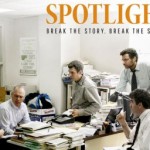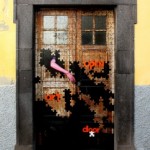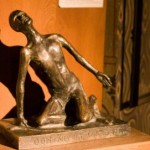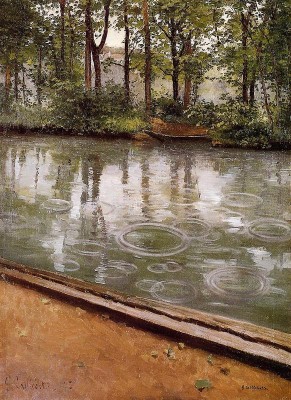 Manna from heaven, so the story tells us, rained down, so that the Israelites, in their long wandering journey to an unknown destination, had each day enough bread for that day. Our imagination is caught by this bread, which Jesus calls the bread of eternal life, and which he also says he is. But in the ongoing journey of human life – and all life – on this planet, we need to pay attention to its raining, and we need to wonder about rain.
Manna from heaven, so the story tells us, rained down, so that the Israelites, in their long wandering journey to an unknown destination, had each day enough bread for that day. Our imagination is caught by this bread, which Jesus calls the bread of eternal life, and which he also says he is. But in the ongoing journey of human life – and all life – on this planet, we need to pay attention to its raining, and we need to wonder about rain.
It is preposterous to think about a raining of bread. It is magical thinking. Some few faithful souls have valiantly tried to find a way to fuse the scientific with the legendary here, but I am unconvinced. But then, I always thought the companion tale in the Exodus story, the rain of frogs upon Egypt, one of the ten plagues, was magical thinking, too.
Cynthia Barnett, in her captivating book Rain: A Natural and Cultural History, records that “hundreds of tiny frogs or fish sometimes fall in a rainstorm, as they have since the beginning of recorded history.” I am astonished. Rain, then, is not limited to just what I know of it: the gentle shower on my garden, or the gale force storms of winter sleeting snow.
Even more important, rain is not an incidental detail in our world. 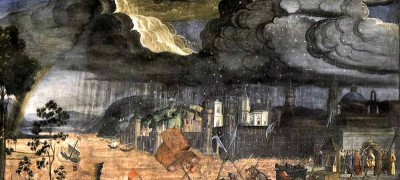 Barnett convincingly summarizes the explorations of science that have shown how rain, over billions of years, created and now sustains the liveable world we know. Rain is the source of rivers and then oceans, rain cooled the ‘red-faced and hellish infant Earth’, and continues to constitute the atmosphere in which Earth remains a green-blue planet. She cites David Grinspoon, chair of astrobiology at the Library of Congress: Water alone is not enough. Water is ‘out there,’ too, — in the atmosphere of Venus and in the polar caps of Mars—but it does not sustain a living world on either of those planets. To become our life force, water also had to build up in the skies, move along with the wind, and pour back to the surface, replenishing the waters, lands, and beings again and again.
Barnett convincingly summarizes the explorations of science that have shown how rain, over billions of years, created and now sustains the liveable world we know. Rain is the source of rivers and then oceans, rain cooled the ‘red-faced and hellish infant Earth’, and continues to constitute the atmosphere in which Earth remains a green-blue planet. She cites David Grinspoon, chair of astrobiology at the Library of Congress: Water alone is not enough. Water is ‘out there,’ too, — in the atmosphere of Venus and in the polar caps of Mars—but it does not sustain a living world on either of those planets. To become our life force, water also had to build up in the skies, move along with the wind, and pour back to the surface, replenishing the waters, lands, and beings again and again.
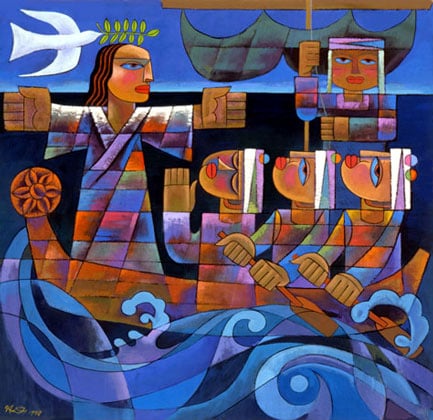 Rain, then, is the mother of life, and the legends are not wrong when they tell us that, in a disastrous time, people were saved by some form of rain, as well as saved from other forms of rain. Barnett notes that in every culture there is a form of worship for rain, prayers, dances, incantations, attempts to induce rain. In our age, chemical cloud-seeding occupies human attention, yet has failed to be an answer to the drying up of the Yangtze River in China or the terrific drought happening in California, where the Colorado River’s drying up has turned lush croplands to dust, while other parts of this nation suffer from ominous superstorms: Katrina, Sandy.
Rain, then, is the mother of life, and the legends are not wrong when they tell us that, in a disastrous time, people were saved by some form of rain, as well as saved from other forms of rain. Barnett notes that in every culture there is a form of worship for rain, prayers, dances, incantations, attempts to induce rain. In our age, chemical cloud-seeding occupies human attention, yet has failed to be an answer to the drying up of the Yangtze River in China or the terrific drought happening in California, where the Colorado River’s drying up has turned lush croplands to dust, while other parts of this nation suffer from ominous superstorms: Katrina, Sandy.
We misunderstand rain, Barnett argues, pointing out that we don’t even imagine water drops in the right shape, and we plan badly around our water needs.
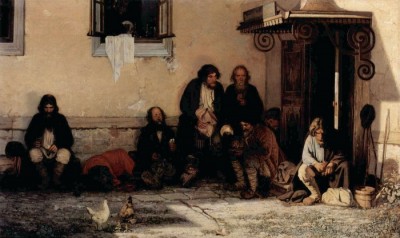 Which is what Jesus said about the bread of heaven: We misunderstand it. We misuse it. We fail to comprehend its potential or our need for it, and instead we engage in magical thinking. Climate change, Barnett says, frightens and divides us, to such an extent that many people simply refuse to talk about it. But everyone loves to talk about the rain.
Which is what Jesus said about the bread of heaven: We misunderstand it. We misuse it. We fail to comprehend its potential or our need for it, and instead we engage in magical thinking. Climate change, Barnett says, frightens and divides us, to such an extent that many people simply refuse to talk about it. But everyone loves to talk about the rain.
Rain, she writes, is an opening to connect—in ways as profound as prayer, as practical as economics, or as casual as an exchange between strangers on a stormy day. Rain brings us together in one of the last untamed encounters with nature that we experience routinely . . . we are bound in the memory and mystery of exhilarating, confounding, life-giving rain.
And all of this is true of the manna in the wilderness, which rained down from heaven. And all of this is true of the bread of eternal life, which Jesus said he was, and which he identified with the manna of heaven. It is an opening to connect, it is as profound as prayer, as practical as economics, and as casual as an exchange between strangers in a difficult time.
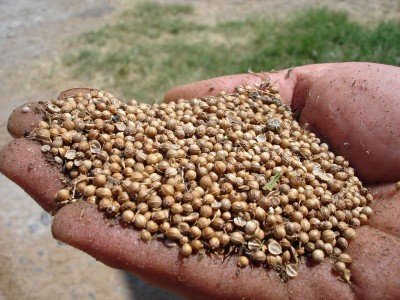 The raining aspect of holy bread should change our thinking about it – from a thing you can hold in your hand, to a thing that holds you in its living. From a thing you can make to a thing that will sustain you but you cannot hold onto it, cannot store it up, cannot paint a still life of its life-force, cannot, in fact, worship it. It is its motility, moving with the wind, moving from the atmosphere, moving again and again into us and replenishing us (us includes the rivers, lakes, and streams from which we drink) that is its power, its life-sustaining essence. I am who I am becoming, said God, who holds this very power indescribably and in motion. And in this we may come closest to understanding Jesus’ self-definition as eternal bread.
The raining aspect of holy bread should change our thinking about it – from a thing you can hold in your hand, to a thing that holds you in its living. From a thing you can make to a thing that will sustain you but you cannot hold onto it, cannot store it up, cannot paint a still life of its life-force, cannot, in fact, worship it. It is its motility, moving with the wind, moving from the atmosphere, moving again and again into us and replenishing us (us includes the rivers, lakes, and streams from which we drink) that is its power, its life-sustaining essence. I am who I am becoming, said God, who holds this very power indescribably and in motion. And in this we may come closest to understanding Jesus’ self-definition as eternal bread.
Hungry, we, like the Israelites, like folks around Jesus, just want to get some bread, and he warns us we need more than this. Whoever comes to me will never be hungry, and whoever believes in me will never be thirsty, and he assures us that nothing that has the taste of him, or the droplet of him, in it, will ever be lost.
It is great hope for the blue-green planet Earth, that its life-giving rain may never be lost. It is also a great work of understanding for us all – and we are in as much of a division over it as were those who heard Jesus’ words, his mystifying, mysterious, exhilarating, confounding, memorable words.
________________________________________________________
Illustrations
1. Yerres – The Effect of Rain, G.Caillebotte, 1875,, Indiana University Art Museum, Bloomington. Vanderbilt Divinity School Library, Art in the Christian Tradition.
2, Crossing the Red Sea Rosselli, Cosimo, 1481, Cappella Sistina Vatican Palace, Vatican City. Vanderbilt Divinity School Library, Art in the Christian Tradition.
3. Peace, Be Still. He Qi. Nanjing, China. 2001 Vanderbilt Divinity School Library, Art in the Christian Tradition.
4. Breadline. 1872. Mjassojedow, Grigorij Grigorjewitsch, Moscow. (This painting, according to the artist, illustrates this text from John’s gospel). Vanderbilt Divinity School Library, Art in the Christian Tradition.
5. Manna, from Biblical Foods and Herbs, Part 6, Yasha Health Blog.


